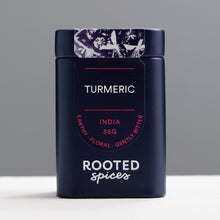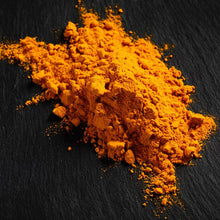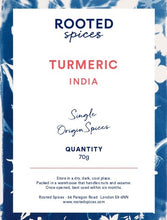- INFO
- WHERE
- RECIPES
- STORAGE
- HEALTH
Turmeric is a rising star in the spice world. It was once seen as ‘poor man’s saffron’, but is now celebrated as a delicious and functional ingredient –Ayurveda describes it as the "one who is victorious over diseases".
Turmeric is in the same family as ginger and the edible part of the plant grows underground. Unlike its fiery cousin, turmeric has a subtler taste: earthy and mellow, with distinctive peppery notes and a gently bitter aftertaste.
Though turmeric is still used as a dye, bright doesn’t necessarily mean better. Often, the opposite is true. The best turmerics are rich golden, rather than canary yellow. The deep colour indicates greater volatile oil content. Unnaturally bright yellow turmeric may indicate that extra colouring has been added.
The spice is usually processed over summer months, when a hot sun helps dry the roots until they have 10-12% moisture and break with a clean snap. The turmeric roots are then ‘polished’ in a bag with stones and ground. Fresh turmeric is increasingly available in British supermarkets (it looks similar to ginger, but with a darker skin and orange flesh), but it's most often dried and pre-ground – tough, dried roots will break home blenders.
Traditional turmeric recipes range from Keralan fish curry, to ayurvedic drinks, like Haldi Doodh (see our Golden Blend). It’s often used in masala mixes and it accounts for the yellow in the curry powder used in Coronation chicken or kedgeree. Turmeric’s boom in popularity means that it’s often used in modern fusions and is a popular health ingredient, often added to porridge and smoothies.
ALSO KNOWN AS: curcuma, haridra, ‘Indian Saffron’
Turmeric needs a warm climate, and is cultivated worldwide – from Haiti to Peru, and even in British greenhouses. The best quality turmeric is found in India where curcumin levels reach up to 5.5% – this impacts colour, taste, and maximises health benefits – and is where we source our turmeric from.
COOK THIS SPICE
Rooted Spices' Favourite Saag Panner
"Tavuk Sis" Grilled Chicken Skewers
Turmeric is a light-sensitive spice and should be stored in an airtight tin to prevent it from losing its potency and becoming musky and stale-tasting.
Turmeric might be the most scientifically studied spice and has risen to fame in the spice world for its health benefits over the past few years. Studies indicate that turmeric and its main active ingredient, curcumin, has powerful anti-inflammatory and antioxidant effects, amongst many others. To read more, click HERE and HERE.
To help the body absorb the benefits of turmeric, we recommend using it alongside black pepper (see our Golden Blend). This is because the piperine found in black pepper boosts the body’s absorption of curcumin. To read more, click HERE.






